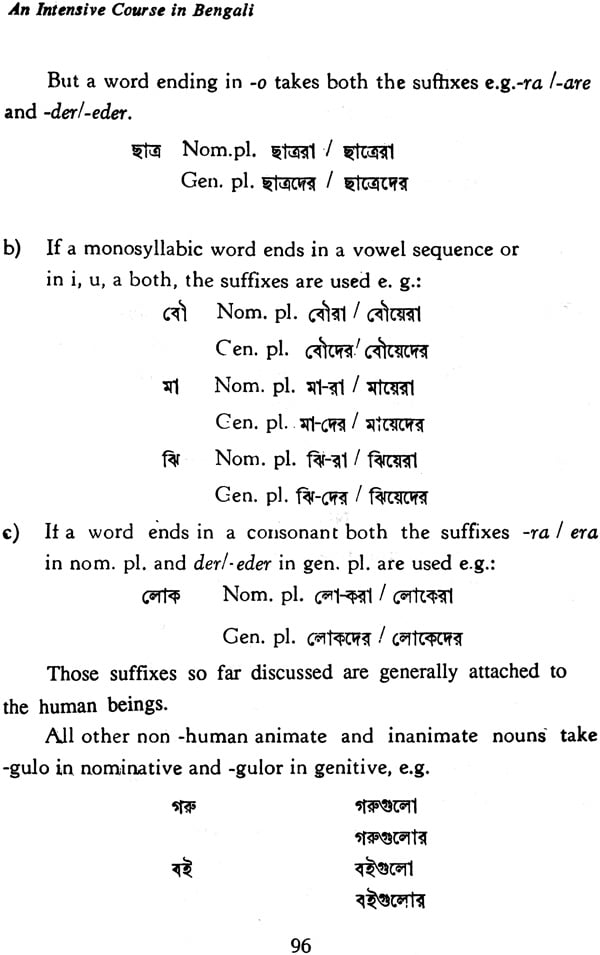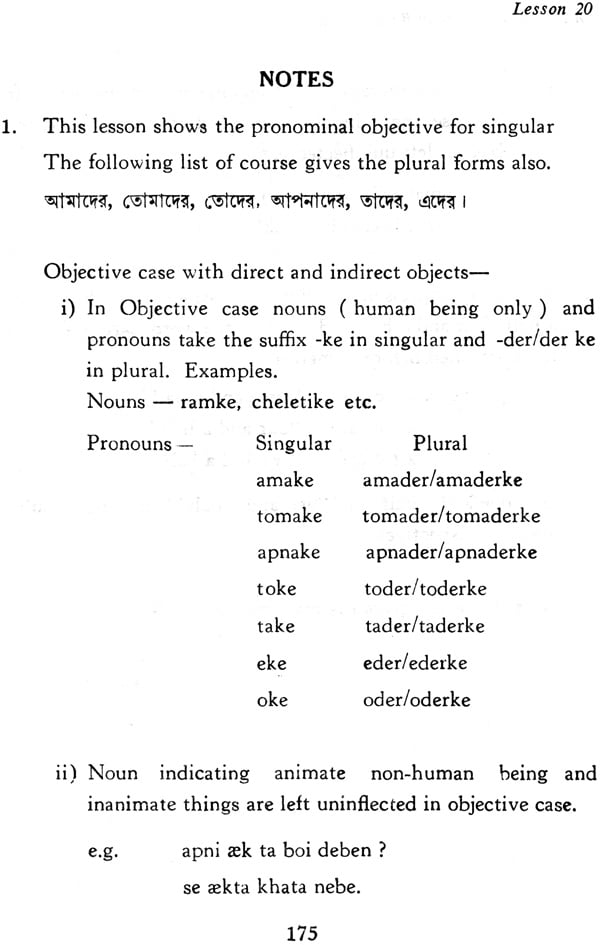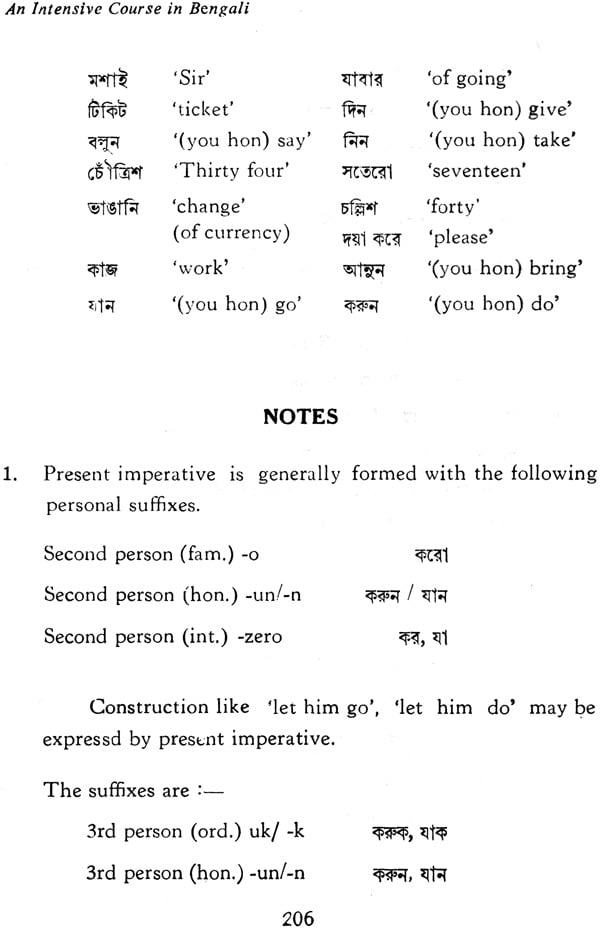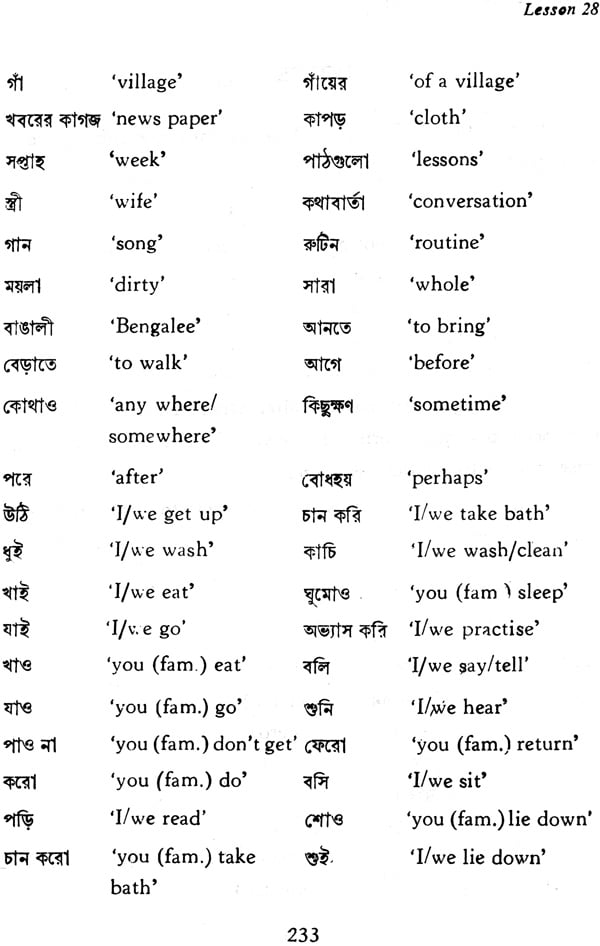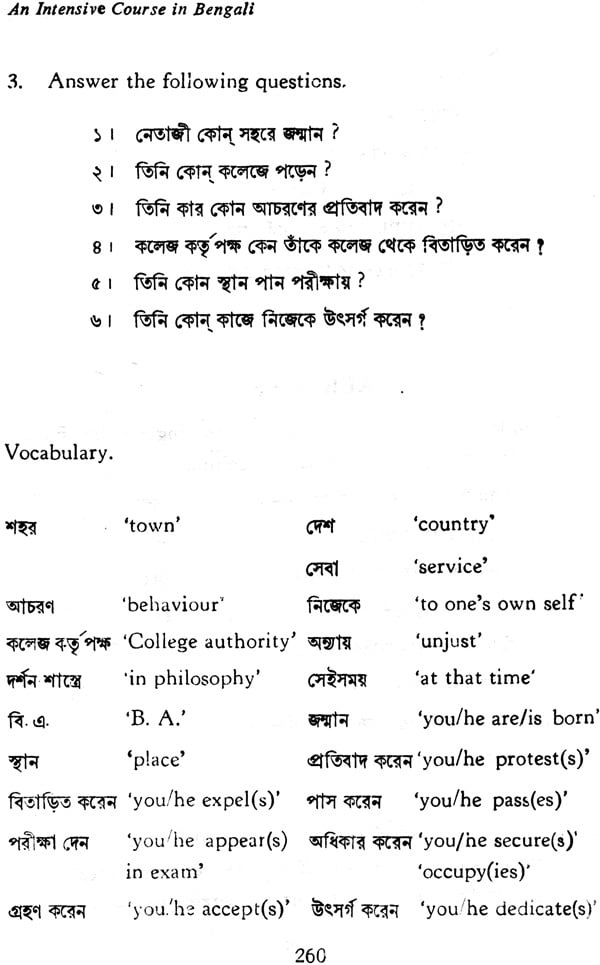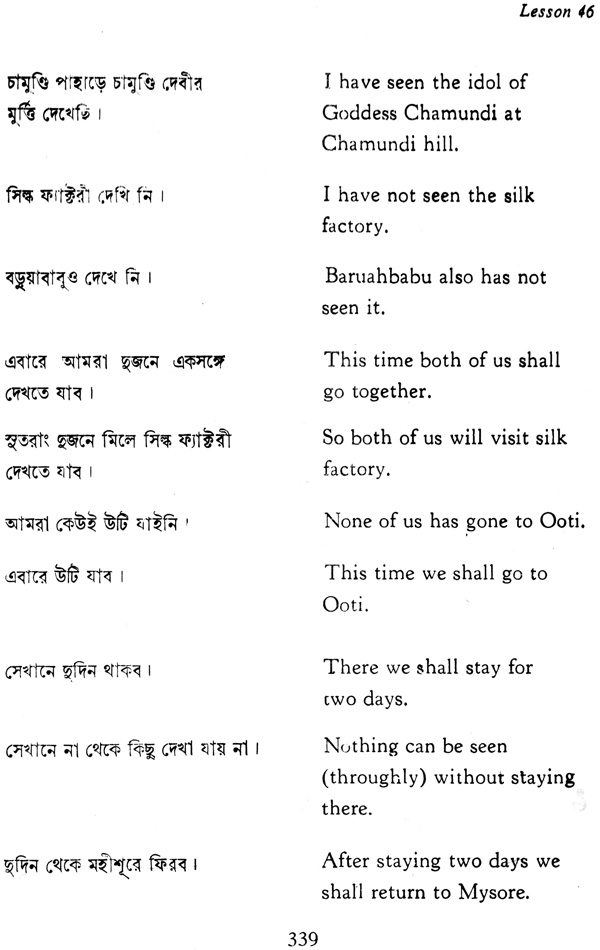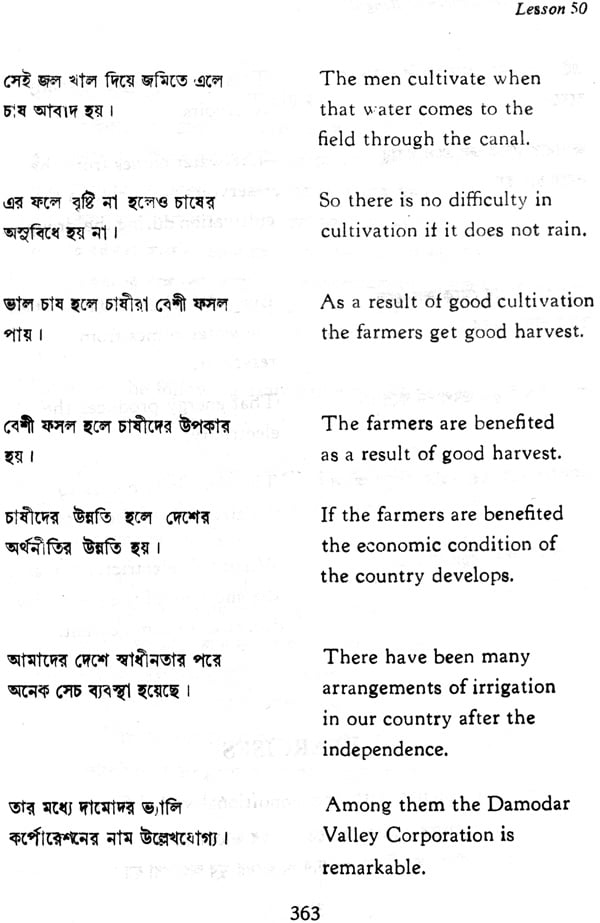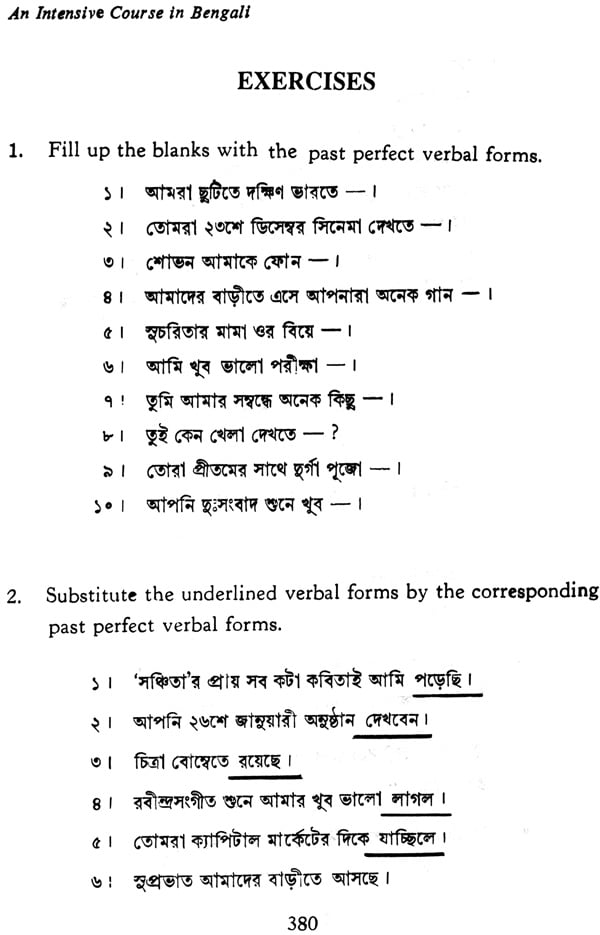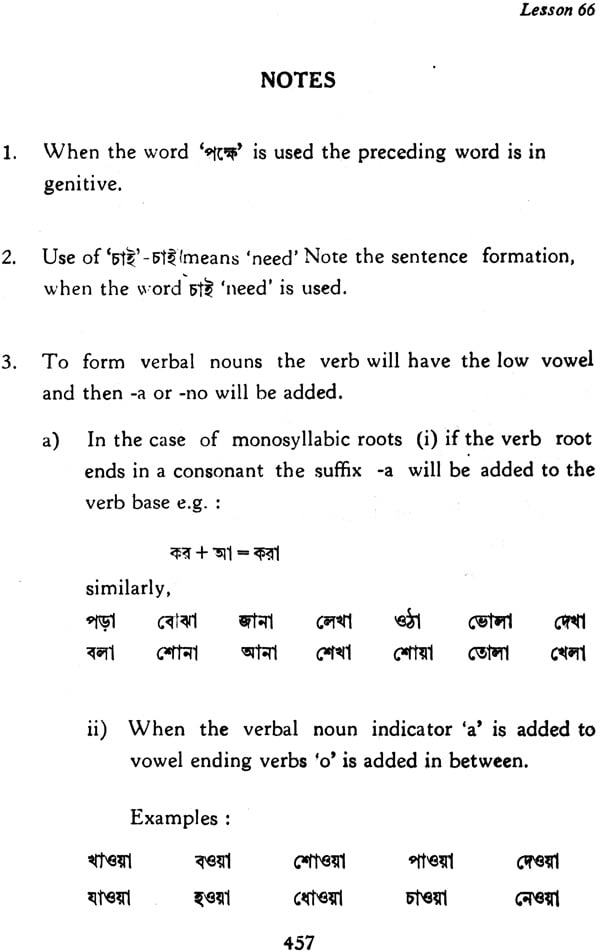
An Intensive Course in Bengali (An Old and Rare Book)
Book Specification
| Item Code: | NAK951 |
| Author: | Krishna Bhattacharya |
| Publisher: | Central Institute Of Indian Languages, Mysore |
| Language: | Bengali Text With English Translation |
| Edition: | 1994 |
| ISBN: | 8173420300 |
| Pages: | 670 |
| Cover: | Hardcover |
| Other Details | 9.0 inch x 7.0 inch |
| Weight | 840 gm |
Book Description
Language learning is a complex activity. Its success is largely dependant on the method, medium, material and the motivation of the learner. Furthermore, the highly organised curriculum and planning help to attain the educational goal easily and quickly.
The present intensive course is meant for developing the listening and speaking skills of the learner. Along with this book several other reading and writing materials like the Phonetic Reader, the Script Book, the semantically classified recall vocabulary and film strips and cassettes for teaching Bengali script and structures, prepared by the Central Institute of Indian Languages Training Programme may be used for the benefit of the learner.
The present book is the prescribed instruction material for the basic course of the Begali language Training Programme of the Central Institute of Indian Languages. The basic course consists of approximately 450 clock hours of instruction with prime emphasis on the spoken language. The present Intensive Course covers approximately 300 clock hours of instruction. This course is equally useful for any generalised second language Bengali teaching learning programme.
The principles that underline this Intensive Course are as follows:
1. Concentration on one objective. at a time: the teacher or the instructor presents the teaching materials in such a way that the learner concentrates on one structure or one teachable item at a time.
2. Selection, gradation and systamatisation of linguistic patterns: The numbers and the kinds of structures are decided with great caution on the basis of objectives of the Basic Course. Then these structures are controlled, systematised and graded from simple to difficult on the basis of the morphological and syntactic complexity. In this connection it should be borne in mind that the structures presented in this cannot be claimed as exhaustive. The structures introduced here are basic and with the acquiring of these structures the learner' will be able to manage day to day activities in a Bengali speaking community.
3. The intensive instruction consists of four basic step : presentation, explanation, repetition and transfer.
4. The teacher who introduces the linguistic patterns can do the classroom drilling. But depending on the intensive nature of the course it may be necessary to divide the responsibilities between separate persons. With this view in mind the teachable patterns are inserted in the body of the lesson and the drills and exercises are presented separately after the lesson.
The present book fulfils the following objectives of the basic courses offered at the Regional Language Centres of the Central Institute of Indian languages.
(i) To be able to form sentences orally from given patterns and lexical items.
(ii) To be able to converse with the teacher and with fellow trainees on specified topics under controlled situations.
(iii) To be able to narrate special events and topics orally.
(iv) To be able to read simple material and daily news paper.
(v) To be able to write simple free compositions and guided complex compositions.
Among the materials for teaching and learning Bengali as a second language so published, one has to refer the Introduction to Bengali, Part I accompanied by tapes, published from East- West Centre Press, Honululu, 1965. by Edward C. Dimock, Jr., Somdev Bhattacharji and Subas Chatterjee. There are two other books as following materials, viz., Introduction to Bengali, part 11 : Introductory Bengali Reader by Somdev Bhattacharji and Bengali Prose Reader by Edward C. Dimok, Jr. and others.
The present work adopts the merits of the book prepared by 'Dirnock, Bhattacharji and Chatterjee, but differs from it in several ways in terms of selection, gradation and presentation. It provides the learner with many different types of conversations in natural setting and presents various types of drills. As a result it leads the learner to use the language more functionally. The book prepared by Dimock and others is mainly meant for foreign students whose mother tongue is English. The present book primarily meant for Indian language speakers other than Bengali, is wider in scope. Lastly, to prepare the present book the authors have aimed at a compromise between purely structural and purely cultural orientation. There are exercises and evaluation-cum-tests as additional items for the improvement of the competence of the learner.
As regards the teaching method to be adopted, the Central Institute of Indian Languages is highly convinced by theory and experience that no single method can explain and guide second language learning as a developmental process. . To attain the goal different flexible and many-sided procedures and techniques may be employed. . Therefore, the method adopted in our language teaching programmes is 'eclectic' incorporating insights from all available sources.
The type of language used in this book is the Standard Colloquial Bengali which is spoken by a large number of people in all over Bengal.
This intensive course consists of 25 units as mentioned in the contents, which are further subdivided into 94 lessons. Each unit contains two or more lessons. Each lesson consists of atleast one grammatical, structure and the whole unit covers a group of related grammatical structures. So far as the time limit of each lesson is concerned, it will take about 3 clock hours of instruction in the classroom. The teachable patterns of the previous lessons are reinforced in the subsequent lessons. At the end of every unit there is a review lesson which exploits in a single place all the structures introduced so far.
The body of the lesson is mainly conversational. But these are also a few pieces of narration.
Each lesson is composed of five parts, a dialogue or a narrative, drills, exercises, vocabulary and grammatical notes in this order. The content of the body of the lesson is determined on the basis of the varied situations that the trainees are likely to be faced with while learning the language and that they may have to convey to their students as teachers. The sociocultural aspects are also taken into account in the selection of the contents.
In the body of the lesson there is free English translation of the sentences to provide the learner with a general comprehension of the content.
The drills are designed in such a way that through pattern practice the learner is trained to reproduce the patterns with automaticity. All the structures introduced in a particular lesson form part of the drills. The various types of drills included in this book are variation drill, repetition drill, build-up drill, expansion drill, response drill, substitution drill, transformation drill and completion drill.
| FOREWORD | v | ||
| EDITOR'S NOTE | vii | ||
| ACKNOWLEDGEMENT | viii | ||
| INTRODUCTION | XIIl | ||
| REFRENCES | xviii | ||
| ABBREVIA TIONS | XIX | ||
| BENGALI ALPHABET | xx | ||
| UNIT LESSON | PAGE | ||
| 1 | 1 | Teacher-student Introduction | 1 |
| 2 | In the Department | 6 | |
| 3 | Photo | 13 | |
| 4 | Classroom objects | 18 | |
| 5 | Revised Lesson | 23 | |
| 2 | 6 | Enquiry and description | 29 |
| 7 | Family | 43 | |
| 8 | Body Parts | 58 | |
| 9 | Revised Lesson | 69 | |
| 3 | 10 | Whereabouts of the, students | 75 |
| 11 | Classroom articles | 90 | |
| 12 | Hostel | 98 | |
| 13 | Rented house | 110 | |
| 14 | Kerala | 117 | |
| 4 | 15 | Visit to Puri | 122 |
| 16 | In the Market | 135 | |
| 17 | Programme of yesterday | 142 | |
| 5 | 18 | Invitation to dinner | 147 |
| 19 | Buying a Saree | 162 | |
| 20 | Shopping | 168 | |
| 21 | Delhi programme | 177 | |
| 22 | Puja holiday | 185 | |
| 23 | Picnic | 191 | |
| 6 | 24 | Visit to film | 196 |
| 25 | Booking Railway Ticket | 200 | |
| 26 | Preparation for an outing | 207 | |
| 27 | Wishes and Commands | 214 | |
| 7 | 28 | A Sunday routine | 223 |
| 29 | Finding a doctor | 238 | |
| 30 | Teaching Bengali in school | 245 | |
| 31 | Going to teacher's house | 251 | |
| 32 | Subhas Chandra Bose | 258 | |
| 33 | Examination | 262 | |
| 34 | Revised Lesson | 268 | |
| 8 | 35 | Durga Puja | 272 |
| 36 | Milk man | 279 | |
| 37 | Revised Lesson | 287 | |
| 9 | 38 | Talking about a tour programme | 291 |
| 39 | In the teacher's house | 299 | |
| 40 | Preparation for a Function | 304 | |
| 41 | Examination | 311 | |
| 42 | Revised Lesson | 316 | |
| 10 | 43 | Conversation on Bengali poetry | 322 |
| 44 | Visit to Planetorium | 329 | |
| 45 | Enquiry about friend | 334 | |
| 46 | Madras | 338 | |
| 47 | Revised Lesson | 344 | |
| 11 | 48 | Cricket Match | 349 |
| 49 | Strike | 355 | |
| 50 | Revised Lesson | 362 | |
| 12 | 51 | Literary Gathering | 366 |
| 52 | Conversation | 375 | |
| 53 | Revised Lesson | 383 | |
| 13 | 54 | Football Match | 386 |
| 55 | Rainy Day | 392 | |
| 14 | 56 | Information about the residence | 396 |
| 57 | A mother and her daughter | 402 | |
| 58 | Staying at Bhubaneswar | 407 | |
| 59 | Visit to Puri | 413 | |
| 60 | Revised Lesson | 418 | |
| 15 | 61 | Two friends | 423 |
| 62 | Request for buying something | 430 | |
| 63 | Order of master to a servant | 435 | |
| 64 | Request for book | 439 | |
| 65 | Going to "the market | 444 | |
| 16 | 66 | Learning a new language | 451 |
| 67 | Goin~ to cinema | 459 | |
| 68 | Saraswathi Puja | 463 | |
| 69 | Vishnupur | 469 | |
| 70 | Revised Lesson | 474 | |
| 17 | 71 | Conversation between a grocer and a | 479 |
| 18 | 72 | Two Brothers | 488 |
| 73 | Calcutta | 495 | |
| 19 | 74 | Hotel accomodation | 502 |
| 75 | Rainy day | 509 | |
| 76 | Revised Lesson | 516 | |
| 20 | 77 | An accident | 522 |
| 78 | Story (Two friends and bear) | 528 | |
| 79 | Conversation between two friends | 536 | |
| 80 | Revised Lesson | 540 | |
| 21 | 81 | Arrangements for entertainment | 544 |
| 82 | Students' strike | 551 | |
| 22 | 83 | A rainy day | 556 |
| 84 | Advice to the language learners | 563 | |
| 85 | F ear of the theft | 569 | |
| 86 | Revised Lesson | 575 | |
| 23 | 87 | Experience of ' a Language centre | 579 |
| 88 | Red Fort | 588 | |
| 89 | Revised Lesson | 592 | |
| 24 | 90 | Invitation to visit a village in West Bengal at the Puja time | 597 |
| 91 | Preparation of a marriage ceremony | 605 | |
| 92 | Revised Lesson | 610 | |
| 25 | 93 | Request to preside over a meeting | 614 |
| 94 | Revised Lesson | 621 | |
| 95 | Visit to Cuttack | 625 |
